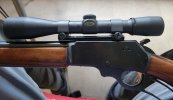I always like a 6x on these 22 Hornet and Bee. Just cause thats what people used as I was impressionable.
You're STILL impressionable.

Of course, that's part of why we love you!

I have long considered 6X plenty of power for a varmint rifle. For many years, I had an old fixed-six, Bushnell Scopechief Command-Post, with a fine cross-hair on my 223 varmint rifle, originally a Ruger No. 3 and later a CZ 527 Varmint-Walnut. Of course, back then I also considered 300 yards a long shot, but it was PLENTY at that range and I remember picking off small targets at that range with that power easily. The ONLY reason it's no longer on my current 223, a Contender Carbine, is that I had a Leupold 3-9 left over from a rifle I sold and my dad had given me that scope. I swapped it onto my 223, because I'm not letting that scope go and didn't want it lying fallow in the safe. GREAT scope, but 9x is not necessary for what I do.
I've owned a lot of 3-9x40s (32s and 38s) only because a 3-9 was the cheapest (least expensive) of just about any line for many years. Often, loss-leader sales were for the 3-9s. Runner up was the fabled 2-7s, of which I've had a few and still have TWO, a Redfield and a Leupold. I honestly PREFER lower powers and fixed, if possible, but the 3-9s and 2-7s sold for prices well below anything I ever actually REALLY wanted. Since they were variables, I could set it where I wanted and leave it at that - USUALLY, either the very top or very bottom.
Honestly, and back to the OP, if I'm remembering correctly WHICH thread this was, one of the older 2-7s might be just the ticket for that Hornet. I have an older Redfield 2-7x32 on my Contender 30/30 and it is slim, sleek and svelte-looking, unobtrusive, light-weight and a wonderful little scope I'll never let go. Perfect for the 30/30 and maybe even perfect for the Hornet, in the absence of a selection of fixed-power scopes.
I say slap a scope on that puppy and bide your time. The perfect scope for that Hornet will come along, but NOT if you're looking for it. Sort of like dating in high-school - when you HAVE a girlfriend, all the girls will talk to you. If you DON'T have a girlfriend, they won't even look at you. Moulds, dies for odd cartridges, scopes, sights - they're all the same. If you LOOK needy, you'll never satisfy the need.

